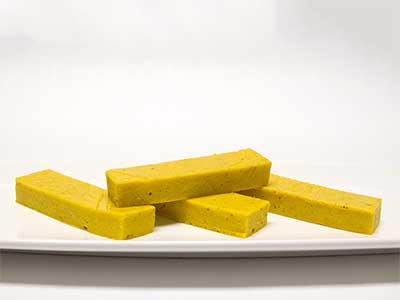April 28, 2014
Amuse-Bouche

fromage au curry
(curried cheese)
I ate dinner by myself at the town’s only Chinese restaurant. It was my last night living in Las Cruces, and I had already said all my goodbyes. Early the next morning I would leave and never return. It had been a long nine months since I left home for my first year of college. It had been a year wasted from an academic sense, but one in which many life lessons were learned.
It was my first Chinese meal since I had left California in the fall. I didn’t recognize many of the dishes on the menu since the local cooking had been adapted heavily to fit with the cuisine of Southern New Mexico. I settled on a dish of curried chicken and rice. The dish was served on the stainless steel, pedestalled plate that was typical of Chinese restaurants of the mid-1960s. At the age of nineteen, it was the first time I experienced the flavor of curry. I liked it.
My second encounter with curry in a Chinese dish occurred at a small restaurant outside of Shanghai in late spring of 1980. One of the dishes we were served for lunch was potatoes cooked in a curry sauce. It was slightly spicy. I liked it.
Eventually I was able to recreate both dishes, but in addition to finding the appropriate recipes, I had to find an appropriate curry powder. For many years, I used the Malaysian curry powder produced in Singapore by Yeo Hiap Seng Ltd. It was relatively expensive, and at times I couldn’t find it in my local Chinese market, which was a hassle.
At some point I decided to stop by the San Francisco Herb Company and check out their products. I decided to give their hot curry powder blend a try even though the minimum purchase quantity was one pound. At four dollars it was significantly less expensive than the Yeo’s I’d been chasing. It also turned out to be very good. I now use this curry powder whenever I can on whatever I can.
So when a recipe called Cheese Curry popped up on The Old Foodie website, I had to give more than a glance. Was it just a variation of Welsh rarebit? Could I maybe use it like a sauce over vegetables?
The recipe came from the January 9th, 1880, issue of The West Australian from Perth, Western Australia. It’s only three sentences long.
Grate a teacupful of rich, hard cheese, and add to it a teacupful of milk, a teaspoonful of mixed mustard and one of curry powder. Stir it over the fire till thick and smooth, and spread it over slices of buttered toast. Brown a few minutes in the oven, and serve hot.
My version didn’t work well as a sauce. It just slid off the vegetables. But when it solidified, it had a nice taste. So I decided to cast it into a block and eat it straight like any other cheese.
I added a little sodium citrate to the mix to turn the combination into “processed” cheese. It became Velveeta with a sophisticated taste.
75 ml (5 T)
whole milk
1.5 g (1⁄2 t)
dry mustard
3 g (1 t)
hot curry powder
5 g
sodium citrate powder
125 g (4-1⁄2 oz)
mild cheddar cheese
1. Line a 7-1⁄2 by 12 cm (3 by 4-3⁄4 in), or similarly sized, cake pan with plastic wrap.
2. Place the milk, mustard, curry powder, and sodium citrate in a small saucepan over high heat. Whisk vigorously until the powders are well dispersed, and the milk comes to a boil.
3. Remove the saucepan from the heat, and add the cheese all at once. Stir vigorously with a rubber spatula until the cheese is melted and smooth.
4. Pour immediately into the prepared cake pan. Chill until firm.
5. Remove the cheese from the cake pan, and wrap with plastic wrap until needed.
Yield: about 8 portions.
© 2014 Peter Hertzmann. All rights reserved.
